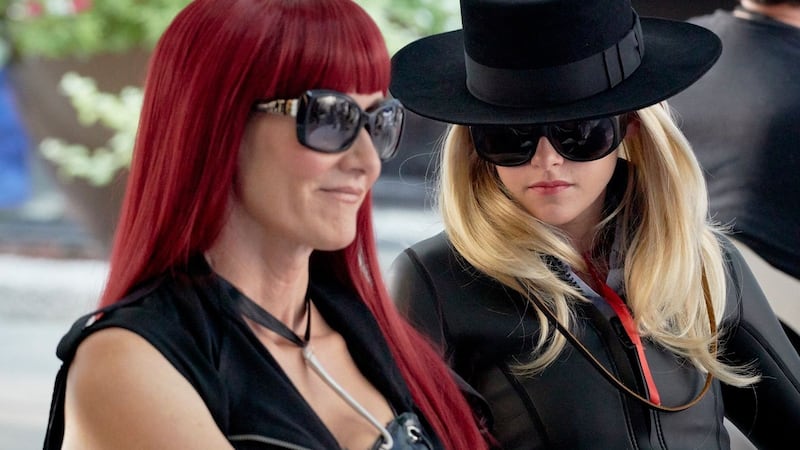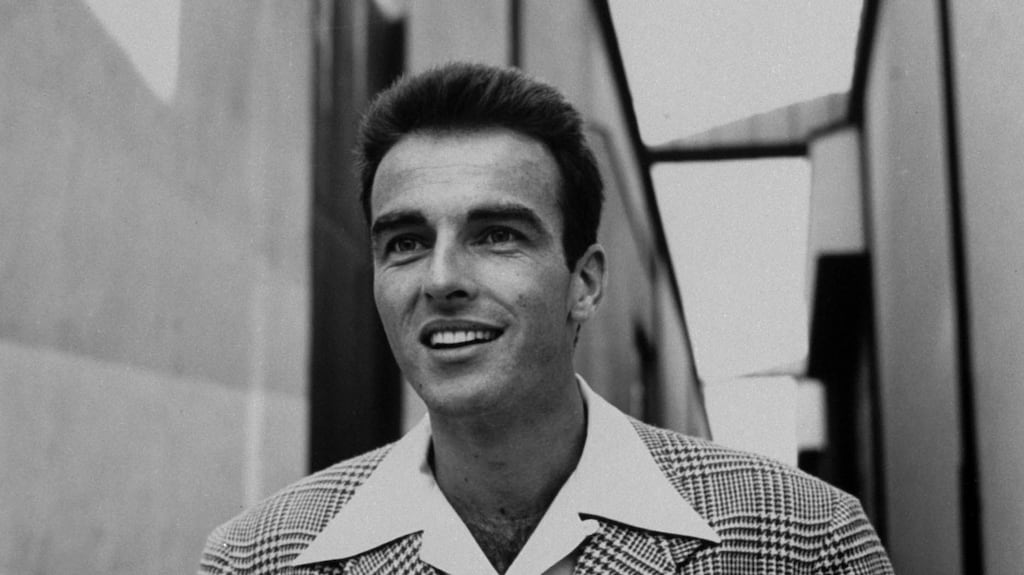For decades the cult around the late actor Montgomery “Monty” Clift has traded on his supposed miseries; he was a beautiful loser, as the title of Barney Hoskyns’s 1992 biography has it.
Not too far in to Making Montgomery Clift, an engaging new documentary portrait of the star of A Place in the Sun and From Here to Eternity, a clip from the gossipy Mysteries and Scandals, broadcast on the E! network, gives the standard pitch: "His extraordinary movie talent enchanted critics and movie-goers alike. His exceptional good looks captured the hearts of millions of women. Even Elizabeth Taylor wanted him. The guy had everything to live for. So why did Montgomery Clift end up an emotionally tormented drug addicted alcoholic living in self-imposed hell? Because Montgomery Clift had a secret he couldn't live with, a secret that haunted him until his dying day."
<a class="search" href='javascript:window.parent.actionEventData({$contentId:"7.1213540", $action:"view", $target:"work"})' polopoly:contentid="7.1213540" polopoly:searchtag="tag_person">Marilyn Monroe</a>, Clift's troubled co-star in The Misfits (1961), called him the only person I know who's in worse shape than I am
That secret, depending on your source, was that Clift was gay or bisexual. Making Montgomery Clift, which was co-directed by Clift’s nephew Robert Clift (and Robert’s wife Hillary Demmon) sifts through an extensive family archive to produce a very different narrative.
Speaking to the film-makers, Jack Larson, who became famous for playing Jimmy Olsen in the hit 1950s TV series Adventures of Superman, recalls how Clift gave him a kiss on the mouth the first time they casually met, and insists that Monty was not remotely worried about being gay: "The thing about Monty was he wasn't anything like people thought he was," says Larson. "He loved to have fun. He had a great sense of humour. As a person he was nearer to Jerry Lewis onscreen than he was to Montgomery Clift."
During a taped phone call with Monty's elder brother Brooks, the actor's mother, Ethel Fogg "Sunny" Clift breezily notes that: "Monty was a homosexual very early. Oh, I think it was about 12 or 13."
Even on-screen, Clift was apt to play the part. He and John Ireland are daringly flirtatious for 1948 in their innuendo-heavy "I'll show you mine" gun scene in Red River. In fact, Clift was considerably less closeted than such gay contemporaries as Rock Hudson and, more generally, he seemed perfectly happy to blaze his own trail.
Born Edward Montgomery Clift on October 17th, 1920, Monty and his siblings, as his nephew Robert notes: "Had an unconventional upbringing; they spent a good deal of time in Europe travelling with their mother and were privately educated by tutors."
In 1935, aged 13, he made his Broadway debut in a New York production of Fly Away Home. Within two years, Hollywood came calling with Tom Sawyer, the first of several plum roles that the actor, who had no intention of getting saddled with a studio contract, would turn down. He would subsequently say no to East of Eden, On the Waterfront, and Sunset Boulevard.
He became one of the first members of the Actors Studio in 1947, alongside Marlon Brando, Julie Harris and Elia Kazan, and while Clift did put in the work – learning how to play the bugle for From Here to Eternity, how to ride a bucking bronco for The Misfits – he was sceptical about "method acting", where an actor fully immerses themselves in a character, and developed his own naturalistic style of acting.
During his Hollywood career, he remained an outsider, negotiating single picture deals, rewriting dialogue, and commuting from his tiny apartment in New York that he rented for $10 a month. He ate the same two meals, consisting of steak, eggs, and orange juice, every day. Between takes, he read Chekov, Aristotle and economic history. He owned one suit and seemed genuinely perplexed when the Saturday Evening Post wrote a story about his bare closet.
Myths
Many of the gay self-loathing myths surrounding Clift come from two biographies: a salacious "pop Freudian" one by Robert Laguardia (who claimed "there was nothing obvious about Monty except for his Oedipal complex") and another questionable work by Patricia Bosworth, titled A Life.
In Making Montgomery Clift, Bosworth makes for a warm, friendly presence, but the film-makers compare and contrast her words with notes and old taped conversations she had with the actor’s brother, Brooks, and find notable discrepancies. (Rather damningly, the solicitation of a “young man” in one source is written up as an approach to a “young boy”).
Making Montgomery Clift also challenges many of the assumptions around Clift’s decline. Many biographers have had fun writing up one of the most glamorous accident scenes in Hollywood history – Monty crashes in Liz Taylor’s driveway and is attended by Taylor and Rock Hudson – and even more fun with the aftermath. Legend has it that, his beautiful face destroyed, Clift becomes increasingly dependant on alcohol and prescription drugs, leading to his premature death in 1966, aged 45.
Marilyn Monroe, Clift's troubled co-star in The Misfits (1961), called him "the only person I know who's in worse shape than I am". Acting teacher Robert Lewis called Clift's late career "the longest suicide in Hollywood history". But as film professor Amy Lawrence argues in The Passion of Montgomery Clift, it's tricky disentangling Clift's dependency on painkillers and alcohol from general post-war drinking habits and the treatment required for his injuries.
In Making Montgomery Clift, the film-makers note that the actor made as many movies after the accident as before. And Jack Larson suggests that Clift preferred his work after the accident.
“On a superficial level, I think there are people who subscribe to the idea that youthful looks are inherently better,” says Robert Clift. “Embedded in that thinking is the narrative that his beauty was a thing that was “lost” at some point in his career.”
Still, one can’t help but wonder how much Monty mythology is rooted in Clift’s extraordinary appearance. In William Wyler’s The Heiress, his co-star Olivia de Havilland gasps: “Father, don’t you think he’s the most beautiful man you’ve ever seen?” Taylor claimed her heart stopped the first time she saw him.
Clift's body of work, which privileges convincing performance over the psychological excavation championed by many of his peers, hasn't dated in the way that some of the mannerisms favoured by Marlon Brando or James Dean have. And yet, he is seldom listed in more canonical film writing. Might Monty's performances have commanded more respect if he weren't so darned good looking?
"There are people, and I think Monty found himself in this camp, who believe that he was able to find more freedom and range as an actor when he no longer fitted the teen heartthrob category," says Robert Clift. "I think as Monty moved through different phases of his life, he used his looks in ways that allowed him to find freedom in his craft. Early on as a sort of heartthrob figure, he got to negotiate single picture contracts that were very outside the norm. Later on, he got to expand the types of characters he played. His characters in A Place in the Sun and Judgment at Nuremberg are very different, but both are solidly crafted performances that we still recognise as outstanding today."
Making Montgomery Clift is screening as part of GAZE International LGBT Film Festival @ Light House Cinema, 1st-5th August, 2019

Three to see at GAZE
Cubby A gay nanny from the US midwest, played by director Mark Blane, strikes up an unlikely friendship with a former sex worker, played by former Interior.Leather Bar star Christian Patrick, in this quirky New York comedy.
JT LeRoy Savannah Knoop (Kristen Stewart) spends six years masquerading as writer Laura Albert's (Laura Dern) literary persona JT LeRoy in a biopic based on Knoop's controversial 2007 memoir.
The Blonde One There are unexpected sparks when womanising Juan moves in with handsome, widowed Gabriel in this new drama from Argentine director, Marco Berger.









